A Novel MATLAB GUI Comparative Technique to Evaluate
advertisement
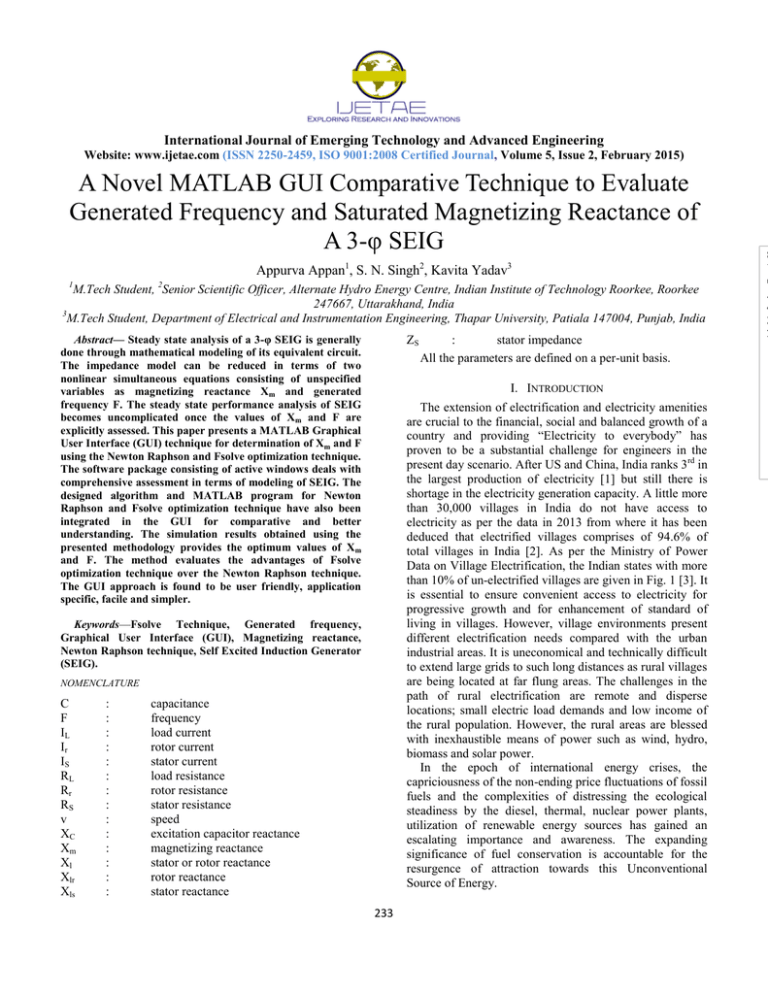
International Journal of Emerging Technology and Advanced Engineering
Website: www.ijetae.com (ISSN 2250-2459, ISO 9001:2008 Certified Journal, Volume 5, Issue 2, February 2015)
A Novel MATLAB GUI Comparative Technique to Evaluate
Generated Frequency and Saturated Magnetizing Reactance of
A 3-φ SEIG
Appurva Appan1, S. N. Singh2, Kavita Yadav3
1
M.Tech Student, 2Senior Scientific Officer, Alternate Hydro Energy Centre, Indian Institute of Technology Roorkee, Roorkee
247667, Uttarakhand, India
3
M.Tech Student, Department of Electrical and Instrumentation Engineering, Thapar University, Patiala 147004, Punjab, India
Abstract— Steady state analysis of a 3-φ SEIG is generally
done through mathematical modeling of its equivalent circuit.
The impedance model can be reduced in terms of two
nonlinear simultaneous equations consisting of unspecified
variables as magnetizing reactance Xm and generated
frequency F. The steady state performance analysis of SEIG
becomes uncomplicated once the values of Xm and F are
explicitly assessed. This paper presents a MATLAB Graphical
User Interface (GUI) technique for determination of Xm and F
using the Newton Raphson and Fsolve optimization technique.
The software package consisting of active windows deals with
comprehensive assessment in terms of modeling of SEIG. The
designed algorithm and MATLAB program for Newton
Raphson and Fsolve optimization technique have also been
integrated in the GUI for comparative and better
understanding. The simulation results obtained using the
presented methodology provides the optimum values of Xm
and F. The method evaluates the advantages of Fsolve
optimization technique over the Newton Raphson technique.
The GUI approach is found to be user friendly, application
specific, facile and simpler.
ZS
I. INTRODUCTION
The extension of electrification and electricity amenities
are crucial to the financial, social and balanced growth of a
country and providing ―Electricity to everybody‖ has
proven to be a substantial challenge for engineers in the
present day scenario. After US and China, India ranks 3 rd in
the largest production of electricity [1] but still there is
shortage in the electricity generation capacity. A little more
than 30,000 villages in India do not have access to
electricity as per the data in 2013 from where it has been
deduced that electrified villages comprises of 94.6% of
total villages in India [2]. As per the Ministry of Power
Data on Village Electrification, the Indian states with more
than 10% of un-electrified villages are given in Fig. 1 [3]. It
is essential to ensure convenient access to electricity for
progressive growth and for enhancement of standard of
living in villages. However, village environments present
different electrification needs compared with the urban
industrial areas. It is uneconomical and technically difficult
to extend large grids to such long distances as rural villages
are being located at far flung areas. The challenges in the
path of rural electrification are remote and disperse
locations; small electric load demands and low income of
the rural population. However, the rural areas are blessed
with inexhaustible means of power such as wind, hydro,
biomass and solar power.
In the epoch of international energy crises, the
capriciousness of the non-ending price fluctuations of fossil
fuels and the complexities of distressing the ecological
steadiness by the diesel, thermal, nuclear power plants,
utilization of renewable energy sources has gained an
escalating importance and awareness. The expanding
significance of fuel conservation is accountable for the
resurgence of attraction towards this Unconventional
Source of Energy.
Keywords—Fsolve Technique, Generated frequency,
Graphical User Interface (GUI), Magnetizing reactance,
Newton Raphson technique, Self Excited Induction Generator
(SEIG).
NOMENCLATURE
C
F
IL
Ir
IS
RL
Rr
RS
v
XC
Xm
Xl
Xlr
Xls
:
:
:
:
:
:
:
:
:
:
:
:
:
:
:
stator impedance
All the parameters are defined on a per-unit basis.
capacitance
frequency
load current
rotor current
stator current
load resistance
rotor resistance
stator resistance
speed
excitation capacitor reactance
magnetizing reactance
stator or rotor reactance
rotor reactance
stator reactance
233
International Journal of Emerging Technology and Advanced Engineering
Website: www.ijetae.com (ISSN 2250-2459, ISO 9001:2008 Certified Journal, Volume 5, Issue 2, February 2015)
The existing alternatives of Grid and Diesel generation
have proved to be inappropriate to solve the problem of
rural electrification completely mainly due to high cost and
operation of the generator at synchronous speed. Thus, the
problem solution needs to be Off-grid. The suitability of
SEIG as a solution for the problem of rural electrification is
shown in Fig. 2.
PROBLEM
RURAL ELECTRIFICATION
Located at far-flung areas
Low Electric load demands
Blessed with Renewable Energy sources
OPTION
S
Fig. 1: Indian States with more than 10% of un-electrified villages
Considering the design and operating aspect, steady state
analysis of SEIG is essential. It should be made viable that
if the SEIG parameters are known, the performance of the
machine can be predicted for a specified capacitance, speed
and load. However, the investigation is difficult because it
requires solution of higher order non-linear equations. The
investigation is complex due to magnetic saturation and
requirement of choosing apt parameters to this
corresponding saturated condition. The evaluation of
equivalent circuit results in nonlinear equations the solution
of which are magnetizing reactance Xm and frequency F for
the specified capacitance, speed and load. Many iterative
techniques have been used in the literature to analyze the
performance of the machine [4-6]. One of the major
analytical but rigorous and tedious techniques was Newton
Raphson technique to evaluate the unknown parameters [78]. This paper covers the MATLAB inbuilt Fsolve
optimization technique for solving the nonlinear equations.
A little attempt has been made in the literature in this
concern [9].
DISADVANTAGE
S
DIESEL
GENERATION
Uneconomical. High fuel Cost
Not Environmental-friendly
High maintenance and short life
GRID
CONNECTED
Integration
of
Renewable
Energy sources is a problem
Operation
mainly
at
synchronous speed
Difficult extensions of grid
Uneconomical due to High line
cost
OFF GRID
Discontinuous Energy
Resources
Specialized Maintenance
requirement
High Investment Cost
SOLUTION
SELF EXCITED INDUCTION GENERATOR
Operation in Standalone Mode
Variable speed operation
Relatively cheaper means of electricity
No requirement of governor and less maintenance
requirement
Environmental-friendly using renewable sources of
energy
Fig. 2: Self Excited Induction Generator (SEIG) as a solution of Rural
Electrification
234
International Journal of Emerging Technology and Advanced Engineering
Website: www.ijetae.com (ISSN 2250-2459, ISO 9001:2008 Certified Journal, Volume 5, Issue 2, February 2015)
However, SEIG has not made been able to make its
mark in the customer market substantially. One of the
major reasons in this regard has been the complicated
design and complex operational analysis of SEIG. There is
necessity for efforts to be made to reduce the shortcomings
and successful implementation of SEIG in the field.
Investigation and design of the machine demands a user
friendly application in order to assess the performance
under distinct varying working states. A Graphical User
Interface (GUI) has been developed that allows users to
perform any action through visual manipulations. This
paper deals with a novel approach of integrating both the
Newton Raphson and Fsolve technique in developed GUI
along with the designed algorithms and MATLAB coding
of respective techniques which results in comparative
analysis of both the techniques. Active windows have been
created to design a complete package for the interested
users that includes equivalent circuit of SEIG and related
nonlinear equations. Fsolve method has been found to be
elegant and simple in solution of the nonlinear equations
and GUI is shown to be a productive asset for designing
and visualize the outcomes.
1.
2.
3.
4.
All the parameters apart from magnetizing
reactance are not influenced by magnetic
saturation.
Stator reactance is equal to the rotor reactance.
Core loss is neglected.
The impact of time and space harmonics is not
taken into account in waveforms of voltage and
current.
Fig. 4: Equivalent per-phase circuit diagram of SEIG with resistive
load
ZS IS = 0
(1)
Where,
II. SEIG MODELING AND ANALYSIS
The induction generator has the capability to engender
energy at variable speeds and this feature is used for its
application in an assortment of means such as Self-excited
mode and the Grid-connected mode. Among the two, SEIG
has more importance in terms of its application in isolated
mode. The block diagram of SEIG can be represented as in
Fig. 3 [10].
(2)
The stator current IS is not equal to zero under selfexcitation and thus, from (1), it can be deduced that the real
and imaginary parts of (2) which is the per-unit stator
impedance can be equated to zero. The derived nonlinear
simultaneous equations in terms of magnetizing reactance
Xm and frequency F can be represented as in (3) and (4).
f1 (Xm , F) = (A1 Xm + A2) F3 + (A3 Xm +A4) F2 +
(A5 Xm +A6) F + (A7 Xm + A8) = 0
(3)
2
f2 (Xm , F) = (B1 Xm + B2) F + (B3 Xm +B4) F +
B5 = 0
(4)
Here A1-A8 and B1-B5 are constant values and defined in
(5).
A1 = -2 RL Xl
A2 = -RL Xl 2
A3 = 2 RL Xl
A4 = RL Xl 2
A5 = (Rr + Rs + RL) Xc
A6 = (Rr + Rs + RL) Xl Xc + Rr Rs RL
A7 = -(RL + Rs) Xc
A8 = -(RL + Rs) Xl Xc
Fig. 3: Schematic block diagram of SEIG
The steady state investigation of SEIG is carried out
using its per-unit equivalent circuit diagram with a resistive
load as shown in Fig. 4. The assumptions for the equivalent
circuit and the loop equation for the middle loop is
presented in equations (1) and (2) [7].
235
International Journal of Emerging Technology and Advanced Engineering
Website: www.ijetae.com (ISSN 2250-2459, ISO 9001:2008 Certified Journal, Volume 5, Issue 2, February 2015)
B1 = (Rs + Rr) RL + 2 Xc Xl
B2 = (Rr + Rs) Xl RL + Xc Xl2
B3 = 2 Xc Xl + RL Rs
B4 = -(Xc Xl + RL Rs) Xl
B5 = -(RL + Rs) Rr Xc
The Newton-Raphson iterative technique has been found
to be appropriate in order to solve simultaneous nonlinear
equations as in (3) and (4). The NR formula is stated as in
(6) where Xm0 and F0 are the initial guess of the unknown
values of Xm and F. The Jacobian matrix denoted by [J] is
defined in (7).
(5)
The solution of simultaneous nonlinear equations of (3)
and (4) is a complicated and rigorous process. The
analytical iterative technique of Newton Raphson method
involves partial derivatives of the equations for building up
Jacobian matrix. A new elegant and simpler technique
would be MATLAB Fsolve optimization tool. The Fsolve
technique reduces the length of algorithm and also provides
the accurate result without inputting the degree of error.
The determination of Xm and F for different values of
speed, load and frequency is important to choose the
machine parameters under magnetic saturation for design
consideration.
(6)
where,
(7)
B. Fsolve Technique
The Fsolve technique is an inbuilt MATLAB
optimization tool which gives the solution of multiple
simultaneous nonlinear equations with accuracy without
any need to input the desired rate of error. The designed
algorithm for determination of X m and F in a flowchart is
shown in Fig. 6.
III. NONLINEAR EQUATION SOLUTION TECHNIQUES
A. Newton Raphson Technique
The designed NR algorithm for determination of Xm and
F in a flowchart is shown in Fig. 5.
Fig. 6: Fsolve Flowchart for determination of Xm and F
IV. EXHIBITION OF DEVELOPED TOOL
This section presents the integration of both Newton
Raphson and Fsolve technique in the MATLAB GUI for
user friendly calculation of simultaneous nonlinear
equations in (3) and (4). Rapid efforts have been made
lately in the literature in GUI analysis [11-13].The principal
window consists of:
1. Equivalent circuit diagram of SEIG.
2. Equations
3. NR Algorithm
4. NR Program
5. Fsolve Algorithm
6. Fsolve Program
7. Interactive window for NR and Fsolve with
editable parameters
The windows from 1-6 will open a file with .pdf
extension.
Fig. 5: NR Flowchart for determination of Xm and F
236
International Journal of Emerging Technology and Advanced Engineering
Website: www.ijetae.com (ISSN 2250-2459, ISO 9001:2008 Certified Journal, Volume 5, Issue 2, February 2015)
Equivalent circuit diagram of SEIG will open Fig. 4,
Equations will open (3)-(5), NR Algorithm will open Fig.
5, NR Program will open Appendix B, Fsolve Algorithm
will open Fig. 6, Fsolve Program will open Appendix C
and the Interactive window can be used for operation. The
principal window of the application is presented in Fig. 7.
In case of NR method, in addition of defining the initial
assumption of Xm and F, the degree of error up to which the
result is desired also needs to be mentioned. An additional
block of Max. It. has been included to define the Maximum
Iterations beforehand in case the program gets into an
indefinite loop.
Fig. 7: Principal window of the application
The outcomes obtained from the Fsolve method is found
to be 17 times faster than the outcomes obtained from the
NR method in the designed GUI application. The
worthiness of suggested method is revealed with the
calculated values of Xm and F under distinct working
speed, capacitance and load as shown in Table I to Table V.
The calculation of base values for machine parameters are
given in Appendix A. Table I shows the value of X m and F
at no load with excitation capacitance C=25µF. The X m and
F values under no load are comparatively smaller. The
values are calculated under loads of 100, 200, 400, 800Ω
and capacitances of 25, 50, 75 and 100µF in Table II to
Table V. It is seen that the values of X m and F increases
with increase in load and decrease in excitation capacitance
values.
V. RESULTS AND DISCUSSION
The machine opted for validation of GUI is 3-phase,
50Hz, 4-pole, 415/240V, 13.2/22.9A, 6.8 kW star/delta
connected SCIM where the per-unit equivalent parameters
are:
Table I
Values Of Magnetzing Reactance And Frequency At No Load With
C = 25 µF
Xm(p.u.)
0.0290
RS = 0.0602, Rr = 0.0453, Xls = Xlr = Xl = 0.0961
The window of evaluated result for a particular value of
load, speed and capacitance is given in Fig. 8.
Xm(Ω)
0.527
F(p.u.)
0.5706
Table II
Values Of Magnetzing Reactance And Frequency With C = 25 µF
RL (Ω)
100
200
400
800
RL(p.u.)
5.5
11
22
44
Xm(p.u.)
0.4899
0.7723
1.0934
1.3839
Xm(Ω)
8.907
14.042
19.880
25.162
F(p.u.)
0.9911
0.9954
0.9976
0.9987
Table III
Values Of Magnetzing Reactance And Frequency With C = 50 µF
RL (Ω)
100
200
400
800
Fig. 8: The window of evaluated output for a specific value of load,
speed and capacitance
237
RL(p.u.)
5.5
11
22
44
Xm(p.u.)
0.3659
0.5436
0.6855
0.7896
Xm(Ω)
6.653
9.884
12.464
14.357
F(p.u.)
0.9890
0.9944
0.9968
0.9980
International Journal of Emerging Technology and Advanced Engineering
Website: www.ijetae.com (ISSN 2250-2459, ISO 9001:2008 Certified Journal, Volume 5, Issue 2, February 2015)
if nargout
[varargout{1:nargout}] =
gui_mainfcn(gui_State, varargin{:});
else
gui_mainfcn(gui_State,
varargin{:});
end
function p = f1f2(a,b)
global a1 a2 a3 a4 a5 a6 a7 a8 b1 b2 b3
b4 b5
syms x y % x = xm and y = f
f1 = (a1*x+a2)*y^3 + (a3*x + a4)*y^2 +
(a5*x+ a6)*y + (a7*x+ a8);
f2 = (b1*x + b2)*y^2 + (b3*x+ b4)*y +
b5;
z = subs(f1,a);
f1v = cast(subs(z,b),'double');
z = subs(f2,a);
f2v = cast(subs(z,b),'double');
p = [f1v; f2v];
end
function z = jac(a,b)
global a1 a2 a3 a4 a5 a6 a7 a8 b1 b2 b3
b4 b5
syms x y % x = xm and y = f
f1 = (a1*x+a2)*y^3 + (a3*x + a4)*y^2 +
(a5*x+ a6)*y + (a7*x+ a8);
f2 = (b1*x + b2)*y^2 + (b3*x+ b4)*y +
b5;
df1x = diff(f1,x);
df1y = diff(f1,y);
df2x = diff(f2,x);
df2y = diff(f2,y);
q = subs(df1x, b);
q1 = subs(df1y,a);
q1 = subs(q1,b);
q2 = subs(df2x,b);
q3 = subs(df2y,a);
q3 = subs(q3,b);
z = [cast(q,'double') cast(q1,'double')
; cast(q2,'double')
cast(q3,'double')];
z = inv(z);
end
function s = calc(a,b)
s = jac(a,b)*f1f2(a,b);
end
err =
str2double(get(handles.edit8,'string'))
;
Table IV
Values Of Magnetzing Reactance And Frequency With C = 75 µf
RL (Ω)
100
200
400
800
RL(p.u.)
5.5
11
22
44
Xm(p.u.)
0.3182
0.4173
0.4961
0.5485
Xm(Ω)
5.786
7.587
9.020
9.973
F(p.u.)
0.9883
0.9932
0.9957
0.9969
Table V
Values Of Magnetzing Reactance And Frequency With C = 100 µf
RL (Ω)
100
200
400
800
RL(p.u.)
5.5
11
22
44
Xm(p.u.)
0.2697
0.3374
0.3871
0.4182
Xm(Ω)
4.904
6.135
7.038
7.604
F(p.u.)
0.9866
0.9916
0.9942
0.9955
VI. CONCLUSION
An effort is made in this paper to solve the SEIG
problem of not penetrating the consumer market by
development of an easy to use application of MATLAB
GUI. GUI has proven to be a very productive asset for
designing and visualizing the outcomes. Several windows
have been created in order to include complete analysis of
SEIG for better understanding. The feature of Newton
Raphson and Fsolve technique has been integrated in the
GUI where the Fsolve method has been found to be
comparatively suitable for evaluation of X m and F. Fsolve
promises substantially simpler algorithm, faster response
and comparatively accurate result since degree of error
need not be defined in its case. This approach can be
considered for evaluating comprehensive performance
evaluation of 3-phase SEIG and its voltage and frequency
regulation problems.
VII. APPENDIX
A. Machine Parameters
Vbase = Phase voltage (rated) = 240 V
Ibase = Phase current (rated) = 13.2 A
Zbase = Base impedance = 18.182 Ω
Pbase = Base power = 3.17 kW
Fbase = Base frequency = 50 Hz
The machine parameters in per-unit are:
Rs = 0.602, Rr = 0.0453, Xls = Xlr =Xl = 0.0961
B. Small section of MATLAB GUI program for NR
if nargin && ischar(varargin{1})
gui_State.gui_Callback =
str2func(varargin{1});
end
238
International Journal of Emerging Technology and Advanced Engineering
Website: www.ijetae.com (ISSN 2250-2459, ISO 9001:2008 Certified Journal, Volume 5, Issue 2, February 2015)
mit =
str2double(get(handles.edit9,'string'))
;
xma = xm;
fa = f;
for k = 1:mit
p = [xma(k) ; fa(k)] calc(xma(k),fa(k));
xma = [xma p(1)];
fa = [fa p(2)];
if p(1) < err && p(2) < err
set(handles.text11,'string',p(1))
set(handles.text12,'string',p(2))
break
end
end
set(handles.text11,'string',p(1))
set(handles.text12,'string',p(2))
b3 = rs*rl+2*xl*xc;
b4 = -xl*(rs*rl+xl*xc);
b5 = -xc*rr*(rl+rs);
s = fsolve(@eqns , [xm f]);
set(handles.text19,'string',s(1))
set(handles.text20,'string',s(2))
REFERENCES
[1]
[2]
[3]
[4]
[5]
C. Small section of MATLAB GUI program for Fsolve
function z = eqns(x)
global a1 a2 a3 a4 a5 a6 a7 a8 b1 b2 b3
b4 b5
z(1) = (a1*x(1)+a2)*x(2)^3 + (a3*x(1) +
a4)*x(2)^2 + (a5*x(1)+ a6)*x(2) +
(a7*x(1)+ a8);
z(2) = (b1*x(1) + b2)*x(2)^2 +
(b3*x(1)+ b4)*x(2) + b5;
end
global a1 a2 a3 a4 a5 a6 a7 a8 b1 b2 b3
b4 b5
set([handles.edit11 handles.edit12
handles.edit13 handles.edit14
handles.edit15 handles.edit16
handles.edit17 ],'string','')
msgbox('INVALID INPUT','TRY
AGAIN','warn','modal')
return
end
a1 = -2*xl*rl;
a2 = -xl^2 * rl;
a3 = 2*xl*rl;
a4 = xl^2*rl;
a5 = xc*(rs+rl+rr);
a6 = xc*xl*(rl + rs + rr)+ rl*rs*rr;
a7 = -xc*(rs+rl);
a8 = -xc*xl*(rs+rl);
b1 = 2*xl*xc+rl*(rs+rr);
b2 = rl*xl*(rs+rr)+xl^2*xc;
[6]
[7]
[8]
[9]
[10]
[11]
[12]
[13]
239
―Electricity Sector in India‖, http://en.wikipedia.org/wiki/Electricity
_sector_in_India, Retrieved 20th January, 2015.
―Rural Electrification: India‖, http://effut.com/knowledgebase/2014/
06/30/rural-electrification, Retrieved 25th January, 2015.
―Models of Rural Electrification Report to Forum of Indian
Regulators‖, http://www.forumofregulators.gov.in/Data/Reports/Fin
al_Foir_Report_5th_March07_Models_of_RE_E&Y%5B1%5D,
Retrieved 25th January, 2015.
K. S. Sandhu, ―Iterative model for the analysis of self-excited
induction generators,‖ Elec. Power Comp. Syst., vol. 31, no. 10, pp.
925-939, Oct. 2003.
T. F. Chan, ―Analysis of self-excited induction generators using an
iterative method,‖ IEEE Trans. Energy Convers., vol. 10, no. 3, pp.
502-507, Sep. 1995.
K. A. Nigim, M. M. A. Salama and M. Kazerani, ―Solving
polynomial algebraic equations of the stand alone induction
generator,‖ International Journal of Electrical Engineering
Education, vol. 40, no. 1, pp. 45-54, Jan. 2003.
S. S. Murthy, O. P. Malik and A. K. Tandon, ―Analysis of Selfexcited Induction Generators,‖ Proc. Inst. Elect. Eng. C, vol. 129,
no. 6, pp. 260-265, Nov. 1982.
A. K. Tandon, S. S. Murthy and G. J. Berg, ―Steady state analysis of
capacitor self-excited induction generators,‖ IEEE Trans. Power
Apparatus and Systems, vol. 103, no. 3, pp. 612-617, Mar. 1984.
S. S. Murthy and R. K. Ahuja, ―Design and Analysis of Three Phase
Self Excited Induction Generators using MATLAB Graphical User
Interface Based Methodology,‖ IEEE International Conference on
Power, Control and Embedded Systems (ICPCES-2010), vol., no.,
pp. 1-5, Nov. 28-Dec. 1, 2010.
S. R. Kumar, P. Raja and M. P. Selvan, ―Virtual laboratory
environment using MATLAB-GUI for teaching of induction
generators,‖ Annual IEEE India Conference (INDICON), vol., no.,
pp. 676-681, 7-9 Dec. 2012.
A. Pradana, V. Sandeep, S. S. Murthy and B. Singh, ―A
comprehensive MATLAB – GUI based performance evaluation of
three winding single phase SEIG,‖ Proc. Drives and Energy Systems
(PEDES), vol., no., pp. 16-19, Dec. 2012.
S. S. Murthy, G. Bhuvaneswari, R. K. Ahuja and S. Gao, ―A Novel
MATLAB Graphical User Interface Based Methodology for
Analysis, Design and Capacitor Estimation of Self Excited Induction
Generators,‖ IEEE Industry Applications Society Annual Meeting
(IAS), vol., no., pp. 1-6, 3-7 Oct. 2010.
Y. N. Anagreh and I. M. Al-Refae’e, ―Teaching the self excited
induction generator using Matlab,‖ Intl. Journal of Electrical
Engineering Education, vol. 40, no. 1, pp. 55-65, Jan. 2003.
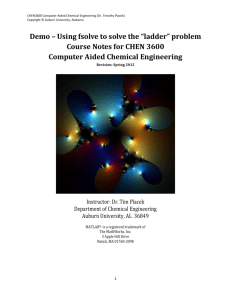

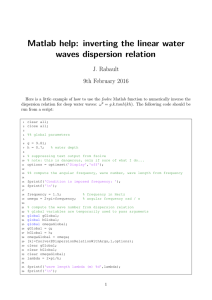
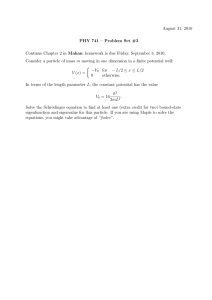
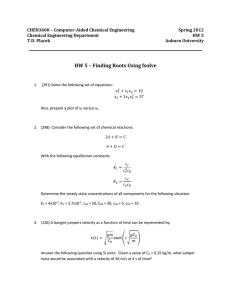
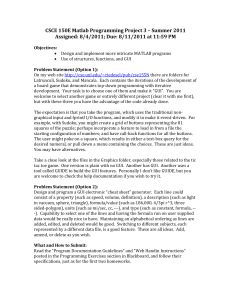
![Let x = [3 2 6 8]' and y =... vectors). a. Add the sum of the elements in x to... Matlab familiarization exercises](http://s2.studylib.net/store/data/013482266_1-26dca2daa8cfabcad40e0ed8fb953b91-300x300.png)